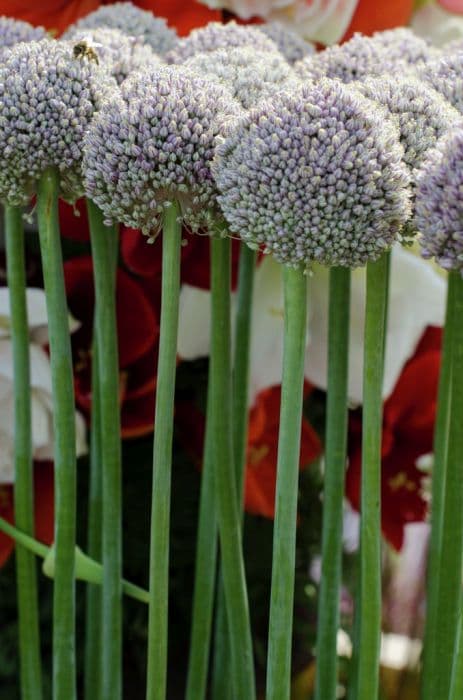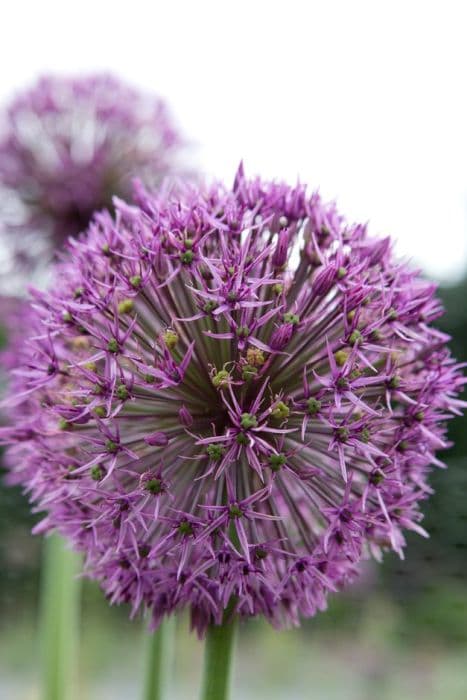Drumstick allium Allium sphaerocephalon











ABOUT
Commonly known as drumstick allium, this plant features a distinctive flower head that is round and tightly packed with small star-shaped blossoms. The flowers are usually a deep purple or burgundy color, creating an eye-catching spherical cluster at the top of a slender, leafless stalk. These flower spheres add a striking architectural element to gardens. The foliage of the drumstick allium is grass-like, with narrow, green leaves that typically emerge earlier in the season before the blooms appear. As an ornamental plant, it is particularly prized for its unique shape and the vibrant color it brings to landscapes. The drumstick allium's appearance is characterized by its round flower heads that seem to float above the foliage, adding a sense of whimsy and movement to a garden setting.
About this plant
 Names
NamesFamily
Amaryllidaceae.
Synonyms
Drumstick Allium, Round-headed Garlic, Round-headed Leek, Sphere-headed Leek, Round-headed Allium, Tennis Ball Allium.
Common names
Allium descendens, Allium sphaerocephalum, Allium sphaerocephalon subsp. descendens, Allium sphaerocephalon var. bulbilliferum, Allium sphaerocephalon var. sphaerocephalon.
 Toxicity
ToxicityTo humans
Drumstick Allium (Allium sphaerocephalon) is not typically considered toxic to humans. Members of the Allium family can be edible, like onions and garlic. However, some people may experience digestive upset or allergic reactions if they are sensitive to these types of plants. It's not advisable to eat ornamental plants as they are not grown for consumption, and their effects can vary. Eating large quantities of Allium plants can potentially lead to symptoms like nausea, vomiting, and diarrhea, but Drumstick Allium is not known for being poisonous to humans when touched or ingested in small amounts.
To pets
Drumstick Allium (Allium sphaerocephalon), like other members of the Allium family, is toxic to pets, especially cats and dogs. If a pet ingests Drumstick Allium, they may experience symptoms such as gastrointestinal irritation, drooling, nausea, vomiting, and diarrhea. In severe cases, the ingestion of Allium species can lead to more serious conditions like lethargy, abdominal pain, elevated heart and respiratory rates, weakness, and even collapse. Hemolytic anemia, where the red blood cells are destroyed, is a risk with significant ingestion. If you suspect your pet has eaten Drumstick Allium, you should contact your veterinarian immediately.
 Characteristics
CharacteristicsLife cycle
Perennials
Foliage type
Deciduous
Color of leaves
Green
Flower color
Purple
Height
2 feet (61 cm)
Spread
1 foot (30 cm)
Plant type
Bulb
Hardiness zones
5
Native area
Europe
Benefits
 General Benefits
General Benefits- Attracts Pollinators: Drumstick alliums are known to attract bees, butterflies, and other beneficial insects, promoting pollination in the garden.
- Aesthetic Appeal: With its unique spherical purple flower heads, drumstick allium adds visual interest and elegance to garden beds, borders, and floral arrangements.
- Drought Tolerance: Once established, drumstick allium is quite tolerant of drought, making it a good choice for xeriscaping or low-water gardens.
- Deer and Rodent Resistant: The plant is typically resistant to deer and rodents, which makes it an excellent choice for gardens plagued by these pests.
- Low Maintenance: Drumstick allium requires minimal care once planted, making it ideal for gardeners looking for low-maintenance plants.
- Naturalizing: Drumstick alliums can spread naturally over time, creating effortless drifts of color without needing replanting.
- Long-Lasting Flowers: The flowers have a long blooming period during the late spring to early summer and also dry well for long-lasting dried flower arrangements.
- Companion Planting: This plant can be effectively used for companion planting to benefit surrounding plants by deterring certain pests.
 Medical Properties
Medical Properties- This plant is not used for medical purposes.
 Air-purifying Qualities
Air-purifying QualitiesThis plant is not specifically known for air purifying qualities.
 Other Uses
Other Uses- Allium sphaerocephalon, commonly known as drumstick allium, can be used in flower arrangements. Its unique round shape and long stem make it a visually interesting addition to both fresh and dried bouquets.
- The seeds of the drumstick allium can be used as a spice. Although not a common practice, the seeds, when harvested and dried, can impart a subtle onion-like flavor to dishes.
- The drumstick allium can serve as a natural pest deterrent in gardens. Planting them among vegetables can help repel certain insects that are attracted to the strong scent of alliums.
- As a dye plant, the drumstick allium can be used in the production of green dyes. The leaves and stems can be processed to extract color for natural dyeing purposes.
- The plant can act as a support structure for weaker-stemmed plants. When planted in close proximity, other plants can lean on the sturdy stems of the drumstick allium for support.
- In photography and art, the distinct spherical shape of the drumstick allium's blooms offers a dramatic subject for close-up photography and botanical illustrations.
- As an educational tool, drumstick alliums can be used in botany classes for studying bulbous plant growth cycles and pollinator attraction strategies.
- Craft projects can benefit from the drumstick allium's unique shape, using the dried flower heads for natural decorative elements in wreaths and ornaments.
- The drumstick allium may be used in companion planting to improve the overall biodiversity and balance of a garden ecosystem.
- In landscaping, the drumstick allium can be planted en masse to create a dramatic visual impact and to add a vertical dimension to garden designs.
Interesting Facts
 Feng Shui
Feng ShuiThe Drumstick Allium is not used in Feng Shui practice.
 Zodiac Sign Compitability
Zodiac Sign CompitabilityThe Drumstick Allium is not used in astrology practice.
 Plant Symbolism
Plant Symbolism- Unity: The tight cluster of blossoms on the ball-shaped head of Allium sphaerocephalon, commonly known as drumstick allium, is often interpreted as a symbol of unity and togetherness.
- Patience: As a plant that takes a while to bloom and comes to its full glory after many other plants have bloomed, drumstick allium can represent patience.
- Humility: Despite its striking appearance when it blooms, drumstick allium spends much of the year as an unassuming green plant, which can symbolize humility.
- Good Fortune: In some cultures, alliums are thought to bring luck due to their unique and eye-catching appearance, and drumstick allium is no exception.
- Prosperity and Success: Drumstick allium's round and full bloom can represent abundance, indicating prosperity and success.
- Strength: Alliums, in general, are known for their strong stems and hardy nature, and drumstick allium can symbolize strength and resilience as well.
- Eternal Life: Many allium varieties have been used in funerary art, signifying the belief in life after death, or eternal life, with drumstick allium carrying this symbolic meaning too.
 Water
WaterDrumstick alliums thrive with consistent moisture, especially during their growing season in the spring and early summer. They should be watered deeply once a week, providing the equivalent of 1 inch of rainfall or about 0.6 gallons per square yard, if natural rainfall is lacking. In periods of drought, increase watering to twice a week, while in wet weather, cut back to prevent waterlogging. It’s best to water these plants at the base rather than overhead, to avoid wetting the foliage which can lead to fungal diseases. During the dormant period in late summer, reduce watering as the plant requires a drier environment.
 Light
LightDrumstick allium prefers full sun conditions, which means at least six hours of direct sunlight each day. The best spot for these plants is in a southern or western exposure where they receive ample sunlight. However, they can tolerate partial shade, especially in hot climates where some afternoon shade can protect them from intense, midday heat.
 Temperature
TemperatureDrumstick allium is quite hardy and can tolerate a wide range of temperatures. They can survive in winter temperatures as low as -4°F and are suitable for growing in USDA Hardiness Zones 4 through 8. The ideal temperature for growth is between 60°F and 70°F. It's crucial to avoid waterlogged soil during cold periods as this can damage the bulbs.
 Pruning
PruningDrumstick allium generally requires little to no pruning. Deadheading, the removal of spent flower heads, is only necessary if you wish to prevent self-seeding. Pruning can be done after flowering, typically in late summer when the flower heads have dried out, by simply cutting off the dead heads. This can help to tidy up the plant and direct energy away from seed production.
 Cleaning
CleaningNot needed
 Soil
SoilDrumstick Allium thrives in well-drained, sandy loam soil with a pH between 6.0 and 7.0. A mixture of two parts garden soil, one part sand, and one part compost or well-rotted manure will create an ideal environment for this plant. Ensure the soil is fertile and has good drainage to prevent waterlogging, which could harm the bulbs.
 Repotting
RepottingDrumstick Allium, being a bulbous perennial, does not require frequent repotting. It's best to divide and repot these alliums every 3 to 4 years to prevent overcrowding and to ensure the bulbs remain vigorous.
 Humidity & Misting
Humidity & MistingDrumstick Allium prefers average humidity conditions and does not require any special humidity adjustments. It is quite adaptable and can thrive in the typical outdoor humidity levels without the need for additional measures.
 Suitable locations
Suitable locationsIndoor
Place Drumstick Allium near a sunny window; water sparingly.
Outdoor
Full sun, well-drained soil, water when dry, and protect from strong winds.
Hardiness zone
4-8 USDA
 Life cycle
Life cycleAllium sphaerocephalon, commonly known as drumstick allium or round-headed garlic, begins its life cycle when a seed germinates in early spring, developing a root system and a shoot that emerges from the soil. In its first year, it primarily focuses on root and foliage growth, forming a basal clump of narrow, green leaves. As it becomes a mature plant in the following year or years, it sends up a tall stem topped with a tight, round cluster of burgundy-purple florets that bloom in early to mid-summer. After pollination, typically by bees and other insects attracted to its flowers, the plant sets seed; the spherical head turns into a capsule containing numerous black seeds. The foliage dies back after flowering and seed set, and the plant enters a dormant phase for the remainder of the year. Each year, the cycle repeats, with the plant sprouting anew from bulbs that have formed underground, often yielding additional plants from offsets and self-sown seeds.
 Propogation
PropogationPropogation time
Spring to early summer
Drumstick allium, or Allium sphaerocephalon, is most commonly propagated through division of bulbs. The best time to propagate these plants is in the fall after the foliage has died back but before the ground freezes. To do this, you carefully dig up the clump of bulbs and gently separate the individual bulbs from the main cluster. Make sure that each bulb has a portion of the base plate, as this is where the roots grow from. Once separated, you replant the bulbs immediately at a depth of about 2 to 3 inches (5 to 7.5 cm) and spaced approximately 4 to 6 inches (10 to 15 cm) apart in well-drained soil. They should be positioned with the pointy end up. This method ensures that the plant will produce blooms the following season.









